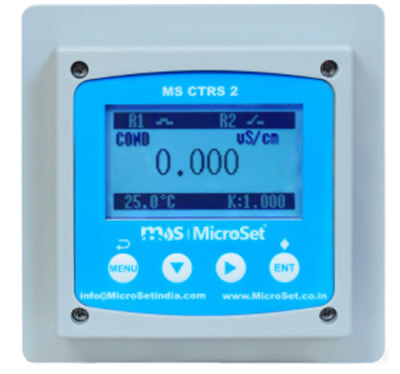

FEATURE
• Advanced Embedded Microcontroller Based Design
• Multivariable Display for Process Value, Relay Status, Temperature & 4 to 20 mA output
• Easy front key five Point calibration
• Auto / Manual Temperature Compensation
• IP66 protection grade
• Password can be set
• 3.2 inch LCD display
• Set Point – 4 Nos
• 2 x 4 to 20 mA DC Isolated output
• Weatherproof IP 66 protection
APPLICATION
• Water Treatment Plant (WTP)
• Wastewater Treatment Plant (WWTP)
• Effluent Treatment Plant (ETP)
• Sewage Treatment Plant (STP)
• RO Water Plant
• Power Plant
• Hydroponics
• Chemical Industry
• Textile Industry
• Paper & Pulp
• Beverages / Food Industry
• Pharma Industry
• Scrubber Application
• Pigment Industry
• Steel Industry
• Aqua Culture
Online Conductivity TDS Resistivity Salinity Temperature Analyzers MS CTRS 2
Conductivity of water allows measuring ionic constituents of all types of water including surface waters, process waters in water supply and treatment plants.
PRINCIPLE
Conductivity is the ability of a solution, a metal or a gas - in brief all materials to pass an electric current. In solutions the current is carried by cations and anions whereas in metals it is carried by electrons. How well a solution conducts electricity depends on a number of factors
• Concentration of ions
• Mobility of ions
• Valence of ions
• Temperature All substances possess some degree of conductivity.
In aqueous solutions the level of ionic strength varies from the low conductivity of ultrapure water to the high conductivity of concentrated chemical samples. Conductivity may be measured by applying an alternating electrical current (I) to two electrodes immersed in a solution and measuring the resulting voltage (U).
During this process, the cations migrate to the negative
Electrode, the anions to the positive electrode and the solution acts as an electrical conductor.
The resistance of the solution (R) can be calculated using Ohm’s law as shown below. The resistance unit is [Ohms] or [Ω].
R= U/I
Where:
U = voltage [V]
I = current [A]
R = resistance of the solution [Ω]
The conductance (G) is defined as the reciprocal of the electrical resistance (R) of a solution between two electrodes. It is measured in Siemens [S] which equals [Ω-1].
TECHNICAL SPECIFICATION |
|
| Principle: | Two electrode |
| Display Range: | Conductivity : 0.00~20.00 mS/cm Resistivity: 0.00Ω.cm~18.00MΩ.cm TDS: 0.00~10g/L Salinity: 15ppt Temp : -10~150℃ |
| Resolution: | EC: 0.001μS /cm Resistivity: 0.01MΩ.cm |
| TDS: | 0.01mg/L Salinity: 0.01% Temp: 0.1℃ |
| Accuracy: | EC: ±1% FS Temp: 0.5℃ |
| Repeatability: | ±0.3% FS |
| Temp Compensation: | Automatic or manual (Pt100) |
| Relay Output: | Two SPST relays, maximum load 3A/250VAC Set high/low alarm, temperature and wash control |
| Communication : | N/A |
| Signal Output: | Two 0/4~20mA current, Max. Load 1000Ω |
| Configuration: | Power failure protection, indefinite retention of Parameters |
| Display: | 128*64 3.2-inch large graphic dot matrix LCD |
| Protection Grade: | IP66 |
| Enclosure Material: | Enhanced ABS |
| Dimension: | 100 x 100 x 120mm (Panel Cutout size 92x92mm) |
| Work Temperature: | 0~60℃, RH<95%, non-condensing |
| Storage Temperature: | -20~70℃, RH<55%, non-condensing |
| Electrical Interface : | Reserve three M12*1.5 gland |
| Installation Method : | Panel |
| Power Supply: | 100~240 VAC 50/60Hz |
| Weight : | 0.45 kg |
Power Consumption : 3W |